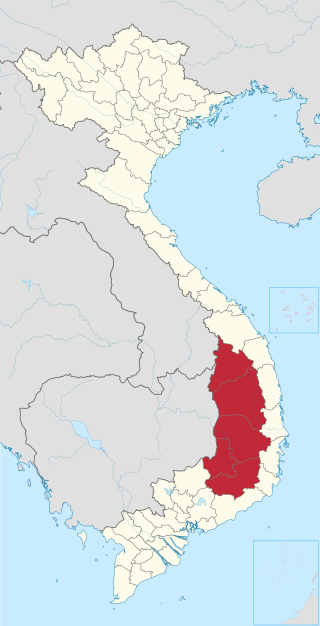
The Việt Minh is the common and abbreviated name of the League for Independence of Vietnam, which was a communist-led national independence coalition formed at Pác Bó by Hồ Chí Minh on 19 May 1941. Also known as the Việt Minh Front, it was created by the Indochinese Communist Party (ICP) as a national united front to achieve the independence of the Democratic Republic of Vietnam.

Montagnards is an umbrella term for the various indigenous peoples of the Central Highlands of Vietnam. The French term Montagnard ( ) signifies a mountain dweller, and is a carryover from the French colonial period in Vietnam. In Vietnamese, they are known by the term người Thượng, although this term can also be applied to other minority ethnic groups in Vietnam. In modern Vietnam, both terms are archaic, and indigenous ethnic groups are referred to as đồng bào or người dân tộc thiểu số. Earlier they were referred to pejoratively as the mọi. Sometimes the term Degar is used for the group as well. Most of those living in the United States refer to themselves as Montagnards, while those living in Vietnam refer to themselves by their individual ethnic group.

Vietnam is divided into 63 first-level subdivisions, comprising fifty-seven provinces and six municipalities under the command of the central government. Municipalities are the highest-ranked cities in Vietnam. Municipalities are centrally-controlled cities and have special status equal to that of the provinces.

Bình Định is a northern coastal province in the South Central Coast region, the Central of Vietnam. It borders Quảng Ngãi to the north, Phú Yên to the south, Gia Lai to the west and the South China Sea to the east.

Ninh Bình is a province of Vietnam in the Red River Delta region of the northern part of the country. The province is famous for a high density of natural and cultural attractions, including reserved parks in Cúc Phương National Park and Vân Long, grotto caves and rivers in Tràng An, Tam Cốc-Bích Động and Múa Caves, historic monuments in the Hoa Lư ancient capital, Vietnam's largest buddhist worshiping complex, and the Phát Diệm Cathedral with "eclectic architectural style". Thanks to its adjacency to Hanoi, day trips from the capital are easily manageable.

The Central Highlands, South Central Highlands, Western Highlands or Midland Highlands is a region located in the south central part of Vietnam. It contains the provinces of Đắk Lắk, Đắk Nông, Gia Lai, Kon Tum, and Lâm Đồng.

Cam Ranh is a city in Southern Khánh Hòa Province, in the South Central Coast region of Vietnam.
Jarai is a Malayo-Polynesian language spoken by the Jarai people of Vietnam and Cambodia. The speakers of Jarai number approximately 530,000, not including other possible Jarai communities in countries other than Vietnam and Cambodia such as United States of America. They are the largest of the upland ethnic groups of Vietnam's Central Highlands known as Degar or Montagnards, and 25 per cent of the population in the Cambodian province of Ratanakiri.

The Bahnar or Ba-Na (Vietnamese pronunciation:[ɓaː˧naː˧] are an ethnic group of Vietnam and the indigenous people of the Central Highland provinces of Gia Lai and Kon Tum, as well as the coastal provinces of Bình Định and Phú Yên. They speak the Bahnar language, a language in the Bahnaric language group that belongs to the Mon-Khmer language family.

Television in Vietnam began to appear in the mid-1960s in Saigon, with the appearance of Saigon Television Station. In 1970, in the North, the Voice of Vietnam broadcast the first experimental television program. Beginning from the late 1970s, color television was introduced and broadcast experimentally. Today, television in Vietnam is available in many broadcasting formats, with many national and local channels, broadcast or pay-per-view with more than 200 channels available to viewers.Vietnam completed the digital television transition in 21 provinces starting on 30 June 2020 and throughout the whole country on 28 December, shutting down all analog signals in the country.

The Chamic languages, also known as Aceh–Chamic and Acehnese–Chamic, are a group of ten languages spoken in Aceh and in parts of Cambodia, Thailand, Vietnam and Hainan, China. The Chamic languages are a subgroup of Malayo-Polynesian languages in the Austronesian family. The ancestor of this subfamily, proto-Chamic, is associated with the Sa Huỳnh culture, its speakers arriving in what is now Vietnam from Formosa.
The Bahnar language or Ba-Na language is a Central Bahnaric language. It has nine vowel qualities and phonemic vowel length.
Nguyễn Văn Lợi was a Vietnamese linguist who served as the deputy director of the Institute of Linguistics at the Vietnam Academy of Social Sciences.
Here are the channel frequency table analog television broadcast/received in the provinces, the territory in Vietnam, divided by regions across the country. Currently, Analog TV nationwide has stopped broadcasting on 28 December 2020 due to government digitization roadmap. Previously, analog television in Vietnam mostly broadcast on the VHF band, and the UHF band, only a few places broadcast less than 6 VHF, like 3 VHF in Tam Dao).










